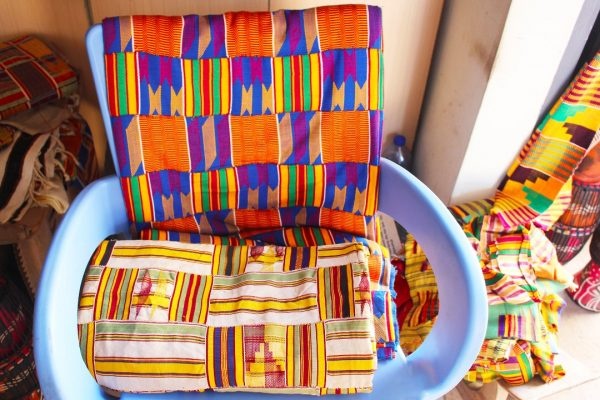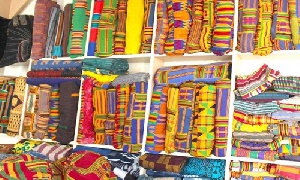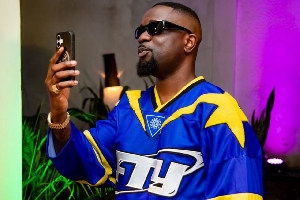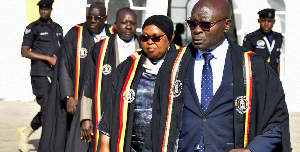Kente, an interwoven cloth strips made of silk and cotton fabrics, is one of Ghana’s rich cultural assets. Mostly worn by chiefs and other traditional leaders, the cloth has been widely accepted by all, especially on occasions that are meant to portray the Ghanaian tradition or heritage.
Coming in different shades of colour and designs, Kente has now developed to be the country’s valuable cloth for all occasions for majority of Ghanains.
Every Kente cloth comes with its own name which is backed by a rich historical reason. The names are based on the designs of the cloths. For instance, we have Adwinasa, Akyempem and Fathia Fata Nkrumah.
Adwinasa literally means all motifs/designs are used up. According to historians, the designer of the cloth attempted to weave a unique cloth to please the Asantehene, King of the Ashanti Kingdom, at the time. In his efforts, he used all the designs then known to weavers in weaving the cloth. In the end he remarked that he had exhausted all the repertoires of designs known to Asante weavers. The cloth was therefore viewed one of top quality and it is the most expensive one. The cloth symbolises royalty, elegance, excellence, and wealth.
Akyempem means thousand shields. This is in reference to shields used by the highly well organised militia consisting of thousands of men and women who defended the Asante Kingdom against external forces. The cloth symbolises military prowess, unity, bravery and exploits among other characteristics.

Fathia Fata Nkrumah is the name couched in reference to the marriage of Dr Kwame Nkrumah, Ghana’s first President, and Fathia, an Egyptian. Fathia was a gorgeous beauty who exuded gracefulness, elegance and majesty among other traits and the Ghanaian public thought Dr Nkrumah was right to choose her for a wife. Fathia Fata Nkrumah therefore means ‘Fathia is a fitting wife for Nkrumah’. The marriage was considered a special union with Pan African ideals.
Upon the overthrow of Dr Nkrumah in 1966, the name was subsequently changed to ‘Obaakofo Mmu Man’, which summarises Nkrumah’s political leadership that prompted the military takeover. His opponents said he had become so autocratic that he portrayed himself as a tingod and one without whom the country Ghana could not run. Obaakofo Mmu Man’ therefore means ‘one person cannot rule a nation’. However, that name could not erase the original one because that specially-designed Kente continues to be popularly known and called Fathia, which symbolises honourable marriage, mutual affection, nobility, and elegance.
Other names include Ankonam, Nyankoton, Adwoa Kokoo, Aberewa Ben, Ohene Afro Hyen, and Abusua ye Duru..

In an interview with the DAILY HERITAGE yesterday, Mr Samuel Osae Bampo, a Kente weaver at the Art Centre in Accra, explained that Ghanaians still cherish the Kente cloth but are driven away by the high prices of its various designs.
According to him, most buyers prefer ‘Fathia Fata Nkrumah’ to most of the other designs because of its elegance.
Though he admitted that the clothes are expensive, Mr Bampo said the stress in designing the cloth is worth the high price.
“We spend months to weave a six yard of Kente cloth. Sometimes we try to work in teams in order to use less time for it but with that we can spend about three to four weeks. The work is really tedious.
“It is sad we cannot manufacture the raw materials in Ghana so we have to import the cotton for our works and it is not cheap. Though it looks expensive, a good Kente cloth is unique and very quality,” Mr Bampo told the paper.
He, however, acknowledged the existence of a ready market for the goods and urged Ghanaians to patronise the locally manufactured ones due to its quality.
Problem of the origin of Kente cloth
There is confusion about the true originators of Kente. It is argued that Kente originated from Bonwire in the Ashanti Region.
The Ashantis explain that Kente comes from the word kenten, which means basket in the Akan dialect. They also refer to kente as nwentoma, meaning woven cloth.
However, the Ewes have also argued that the weaving of Kente originates from them, although they are not claiming they invented the art of weaving.
They suggest that the name is derived from Kete, which are two words put together. Ke means open, and, te is drag.
The name explains the process by which the cloth is woven. In weaving the cloth, the weaver opens and drags the cotton to form a nice piece of cloth.
Meanwhile, the people of Agotime in the Volta Region celebrate the Kente Festival to showcase the richness of the cloth.
As part of events to mark the festival, there is a Kente exhibition where the populace is allowed to showcase the cloth and entreat the younger generation to learn how to weave it.
In view of this, Mr Bampo, who has 54 years’ experience in Kente weaving, said Ghanaians should not be concerned with the origin of the cloth but should be proud of it as something unique from Ghana.
“To me, the issue of who brought Kente to Ghana should not be our concern. Whether it originated from the Ashanti, Volta, or Northern regions doesn’t matter because we are all Ghanaians. We should be happy that Kente is from Ghana and no other place,” he stated.
Though he explained that there are differences in the designs of the cloth from the other ethnic groups, he entreated Ghanaians to desist from making tribalistic comments about the origin of the cloth.
Mr Bampo appealed to the Ghana Education Service to employ craftsmen to teach students to be crafty.
“Dr Nkrumah introduced this sometime ago and it helped. People came out of school and had some work to do and not to wait to be employed in an office,” explained.
Business News of Friday, 15 September 2017
Source: kasapafmonline.com













